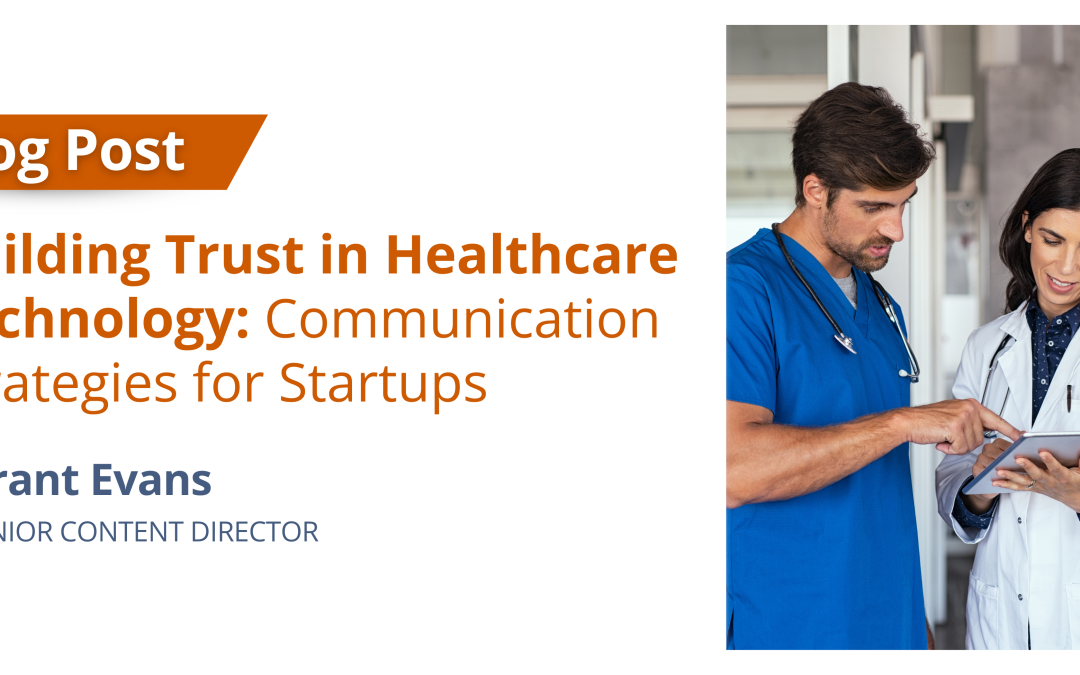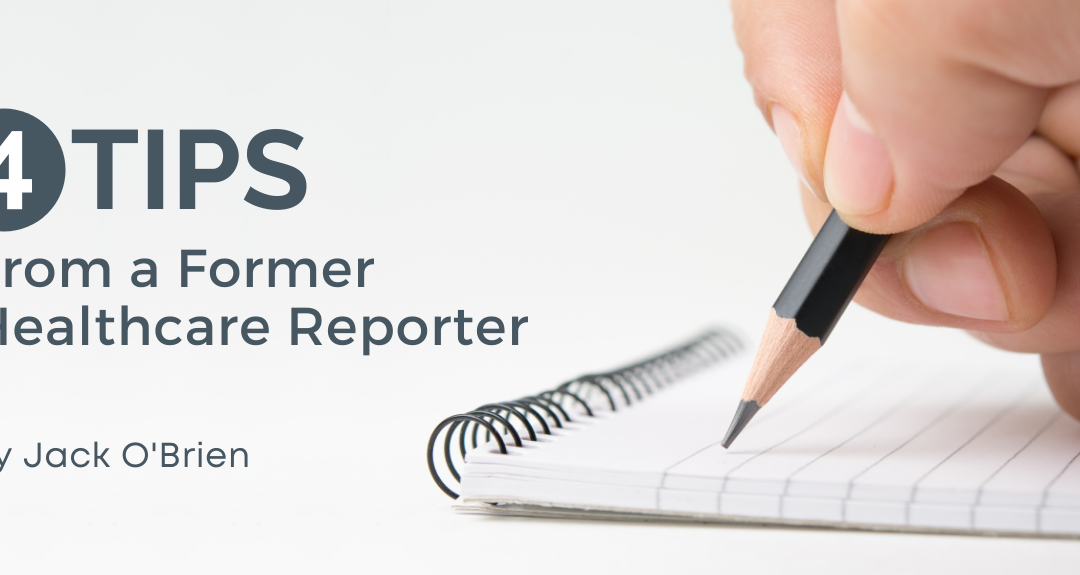
by Grant Evans | Mar 19, 2025 | Blog
In healthcare technology, trust isn’t just a marketing goal—it’s the foundation of success. While established healthcare brands leverage decades of reputation, startups face the unique challenge of building credibility from scratch in a sector where mistakes can have serious consequences.
Leveraging Expertise Strategically
Your team’s credentials and experience are your first trust-building assets. However, many health tech startups underutilize these valuable proof points. Beyond simple bio pages, consider developing thought leadership content that showcases your team’s deep understanding of healthcare challenges and solutions. Regular blog posts, whitepapers, and speaking engagements help position your experts as reliable voices in the field.
Data-Driven Credibility
Original research and survey data are powerful trust-building tools. Consider conducting annual industry surveys that explore healthcare technology trends, challenges, and adoption patterns. This primary research can fuel an integrated content strategy:
- Transform survey insights into comprehensive ebooks and whitepapers
- Create press releases highlighting key findings for media coverage
- Develop social media campaigns featuring data points and infographics
- Gate premium content to capture leads while building authority
- Use data points in media pitches to secure coverage and commentary opportunities
This approach positions your startup as a knowledge leader while generating valuable marketing and PR opportunities. Media particularly value exclusive data, making your startup a go-to source for industry insights.
Establishing Partnerships
Strategic partnerships with established healthcare institutions can significantly accelerate trust-building. Whether it’s pilot programs with hospitals, research collaborations with medical schools, or integration partnerships with established health tech platforms, these relationships signal credibility to your target market.
Many successful health tech startups begin by focusing on a single respected partner, perfecting their solution in a real world environment before expanding. This approach provides valuable case studies and testimonials—essential tools for building broader market trust.
Demonstrating Compliance and Security
In healthcare, compliance isn’t just about checking boxes—it’s about protecting patients. Clear communication about your regulatory compliance status, security measures, and data protection protocols is crucial. Consider creating dedicated security and compliance content hubs that explain complex requirements in accessible terms.
Be transparent about your current stage and future roadmap. If you’re still working toward certain certifications, communicate your progress and commitment to meeting industry standards.
Creating Evidence-Based Content
Healthcare decisions require solid evidence. Develop content that demonstrates both your solution’s effectiveness and your understanding of healthcare’s complexities. This might include:
- Detailed case studies with measurable outcomes
- Research collaborations and clinical validation studies
- Regular analysis of healthcare trends and challenges
- Clear explanations of your technology’s scientific foundation
Building Media Relationships
Focus on building relationships with healthcare technology journalists and influencers before you need coverage. Provide them with genuine insights, exclusive data, and expertise, not just company news. When you do have news to share, these established relationships will help ensure more informed, credible coverage.
Leveraging Agency Expertise
For many health tech startups, partnering with an experienced communications agency can accelerate trust-building efforts. The right agency brings established media relationships, content development expertise, and integrated campaign experience. They can coordinate media and analyst relations while developing compelling content that showcases your expertise.
However, success requires more than just hiring an agency. Designate a dedicated in-house resource to serve as the primary liaison. This person should facilitate content approvals, coordinate subject matter expert interviews, and monitor industry developments that could fuel new content or media opportunities. This partnership approach ensures your agency can execute effectively while maintaining alignment with your company’s goals and expertise.
The Long Game
Trust in healthcare technology isn’t built overnight. A consistent, multi-channel approach focused on expertise, evidence, and transparency will gradually establish your startup as a credible player in the healthcare ecosystem. Remember, in healthcare technology, trust isn’t just about marketing—it’s about demonstrating your commitment to improving patient outcomes and advancing healthcare delivery through validated, data-driven approaches.

by Brandon Glenn | Sep 18, 2024 | Blog
You’ve done the hard work of crafting a public relations strategy, researching the right media targets, and pitching the story to journalists.
Reporters have responded positively to your pitches and are interested in setting up interviews to learn more about your company and executives’ viewpoints. Now what?
For most companies, and in particular startups, media interviews represent a valuable opportunity to introduce their stories, value propositions, and reasons for existence to a broader audience of potential customers, investors, employees, stakeholders, and other industry participants.
However, executives are sometimes hesitant to engage in interviews because they are reluctant to put in the time to mentally prepare or are fearful that reporters will ask them difficult or confusing questions.
The good news for health IT leaders is that there is little to fear. By doing a little homework and preparation prior to a media interview, executives can approach the event with calmness and confidence.
The following are four preparation tips to ensure media interview success:
Turnabout is fair play: Once the interview starts, the reporter will ask many questions of you. Before the interview, take advantage of the opportunity to gain clarity about reporters’ intentions by turning the tables and asking them a few questions. Who is the publication’s audience? What is the reporter interested in talking about? Will she share a list of questions prior to the interview? Do your diligence to make sure the opportunity is worth the time.
Get to know the reporter: Take some time to perform a little pre-interview research about the reporter, browsing through her bio or LinkedIn profile. Read through some of the articles she’s previously written. By getting a feel for the reporter’s background and interests, executives gain fodder for rapport-building pre- and post-interview small talk, demonstrate that they value the reporter’s time and work, and set the stage for follow-up coverage.
Craft talking points: As the one asking the questions, the reporter is generally in control of the interview, but that doesn’t mean that the interview subject is merely along for the ride and must go wherever the reporter steers the conversation. Executives should come prepared with a few basic talking points that expound upon the problems they solve, the negative consequences of those problems for their customers, and why their solution is the right choice to solve these problems. Talking points should be quick, straightforward, and conversational. Repetition of key points is encouraged.
Follow-up and promotion: During interviews, executives often make points or cite statistics that require further clarification or verification by reporters. Be sure to follow up to see if the reporter needs any further information. After the article goes live, promote it through all available channels, including social media, company blog, website, and email to customers and prospects.
Unless your company is an industry giant or a household name, opportunities for media interviews don’t come along that often. When they do, set yourself up for success by investing the necessary time and effort into interview preparation.
For more media interview preparation tips, check out this post from my colleague Philip Anast.

by Jack O'Brien | Oct 13, 2021 | Blog
Career changes are rarely easy, especially when you study a field throughout college and subsequently work in it following graduation.
In August, I left a respected healthcare trade journal after nearly four years and ‘crossed over to the dark side,’ as they say.
There were several professional motivations behind the move, but one that excited me about joining the world of public relations (PR) was that I had already worked with numerous agencies during my time on the editorial side.
As I’ve settled into my new role, I wanted to share four observations on the PR strategies that I found most effective while in my capacity as a journalist.
1. Understand who you’re pitching to
Every PR representative should take time to do their research on the journalists and outlets that they’re pitching.
In my time at the magazine, I primarily covered healthcare finance, policy, and revenue cycle, among a handful of other industry-related topics. Still, I received countless emails from aimless PR representatives pitching me everything from CBD oils to a historian for the band Aerosmith. (Yes, this actually happened.)
Even those that understood I covered the healthcare industry for an audience of payer and provider executives would occasionally float article ideas and interview opportunities that simply missed the mark.
If you’re looking to place a byline or secure earned media with an interview opportunity, make sure you know who you’re speaking with and why it’s worth their while. I always found myself most responsive to PR representatives who weren’t just looking for free publicity but could see down the field about how the interaction would lead to a greater result for both sides.
2. Get to the point (and have other options available)
The only thing worse than getting a random PR pitch that’s off-topic is being forced to read several paragraphs to find out it’s irrelevant.
Short, timely pitches are always winners. The pitch should tell me what the topic is, who can speak to it, and when they’re available.
Additionally, a pitch should offer flexibility for both the PR agency and the outlet. If you’re pitching a potential source as an expert on revenue cycle management but they can also speak to the price transparency regulations and the effects on provider organizations, mention that in your email.
You should be providing as many onramps as possible for a client to appear in a story.
3. Relay expectations to your client
Understandably, most clients probably don’t fully understand how the world of PR and media works. That’s fine, but you have to be the one who explains the dynamics at play so they’re not disappointed by outcomes that don’t match their expectations.
Not every interview is going on the front page of The New York Times, but every speaking engagement, written Q&A, or byline adds up to meaningful coverage.
Additionally, media training to refresh even the most charismatic leaders should be the standard. During interviews I conducted as a journalist, I learned quickly which PR contacts had adequately gone over their notes with my subjects ahead of time and which ones threw them headfirst into the fire.
Don’t leave your clients treading water; let them know what the opportunity is about, why they’re qualified to speak on the subject, and prepare them for any extraneous questions.
4. Create a conversation
Some of the most reliable PR contacts from my journalism days were people who didn’t just pitch me and disappear into the night.
They stuck around and actually engaged with me as normal people do. Whether this was sending the occasional email to see what stories I was working on, interacting with each other on social media, or reading my content, it kept them in my purview as I went about my job.
Additionally, whenever I had a story to write on a tight deadline, I knew I could reach out to these reliable PR contacts and get the appropriate sources on the line.
This doesn’t mean that you have to be chummy with every journalist you come across, (odds are they aren’t always going to chummy in response), but breaking down the at-times acrimonious barrier between church and state can be helpful.
I hope that these tips based on my understanding of how media outlets operate can provide the world of PR with some useful tips to be more effective in the work we do.
by Grant Evans | Aug 18, 2021 | Blog
So, you want to engage a PR agency to help get the word out about your solutions or services.
Sounds like a plan. Sounds easy.
But the process can be daunting, time-consuming, and expensive. And, most importantly, it may not help you achieve your goals.
If this sounds oddly pessimistic coming from someone in an agency, bear with me. I’m here to share some considerations, observations, and best practices gleaned from over three decades split between agency and corporate marketing gigs. Avoiding the mistakes of others can save you time and money, and result in a productive, positive working relationship with your agency.
Know what you want to accomplish.
Do you need straight-up media relations? Industry analyst engagement? Help with messaging and positioning? Social media strategy and support? Editorial and content development? Speaking opportunities? Is there the potential for crisis management? Will your executives require media training?
Having a grasp of your near- and longer-term objectives can help you narrow the field. Most agencies will claim to provide a full menu of such services, but the quality and scope of the offerings can vary wildly. Be skeptical and do your due diligence.
PR Agency? Full-Time Employee? Freelancer?
There are pros and cons to each of these approaches, and your organization’s budget, timeline, and internal processes will dictate the best approach.
Agencies can be expensive, depending on the retainer structure or the billable rates of your account team, but can actually be more cost-effective than the alternatives. They also bring a wealth of expansive and deep marketing expertise, along with a solid bench. They are often very good at helping determine what you need (see above), are responsive and reliable, and 100% dedicated to your agenda. Agencies also provide access to a host of services––from art/creative direction and design, to web development, digital marketing, and social media strategy and support.
Full-time employees are great because they are invested in your success and are in it for the long haul. But they often require substantial budget outlays, and can take months to identify, recruit, sign, and onboard. Once they are thoroughly steeped in your offerings, they can be outstanding brand ambassadors and stewards, and can also work on other marketing initiatives as needed. But once they leave, you’re back to square one.
Freelancers can be nimble hires––they often have excellent credentials, can start right away, and hit the ground running. But they typically operate with minimal resources, have no back-up, and must dedicate hours to other clients. They also can be brutally hard to integrate into existing systems (HR/accounting, project management, content management). They also are prone to terminating their arrangements abruptly (which can also work in your favor if you only need a limited engagement).
One size does not fit all.
Yes, big agencies have big resources, but don’t let claims of a national footprint, local presence, global reach, or head count sell you on an ill-matched relationship. Think expertise, applied experience in your market, and skillsets that dovetail with your agenda. Access to creative resources is a plus. Know how many hours are available to your account each week or month.
Who’s on the team?
This consideration also hinges on knowing what you want to accomplish. If you’re looking for a clip shop to get you mentioned in every low-value round-up article, then seniority matters little. But if you’ll need responsive counsel with expertise in and contacts spanning your market, look for senior-level account team members. Ask the tough questions: What’s the average tenure of your account team? Where have they worked? What companies have they represented? What results have they generated? How many former journalists are on staff? How many accounts do they manage at once?
Mind the old switch-a-roo.
Let’s assume you’re down to a few final candidates and are evaluating pitches. For these meetings, most agencies will send out the big guns––often including the person with his/her name on the door. But will you ever see or hear from these folks again? Many times, agencies get a bad rap by orchestrating a senior executive dog-and-pony show, only to later hand the account over to junior staffers (or even interns) who, while eager, often require more direction and a longer ramp-up period. Get firm commitments on your team’s composition, and don’t hesitate to challenge if you aren’t sold on the match. You want them to operate as an extension of your team.
Beware of scope creep.
Will the agencies you are considering be able to accommodate your needs as your marketing strategy evolves? If your program may eventually require social media support, make sure the agency of record has the capabilities––and not just an intern with a huge stable of Instagram followers, but applied expertise in cultivating an online presence with a custom mix of organic and paid content. Ditto for the media training and crisis communications mentioned earlier. Otherwise, you’ll be saddled with the chore of evaluating and enlisting additional vendors.
In the end, it’s entirely up to you, and highly dependent on your organization’s budget, processes, and requirements. And remember, the old adage, “Fast, cheap, or good? You can only pick two” applies here as well. If you want something fast and good, it won’t be cheap; if you want it cheap and good, it won’t be fast; and if you want cheap and fast, it won’t be good. Choose wisely.

by Brandon Glenn | Jun 10, 2020 | Blog
Another year, another Cision “State of the Media” report.
The 2020 edition, which represents the 11th annual report in the series, surveyed more than 3,200 journalists from across the globe to provide a picture of today’s media landscape. While much of the yearly report generally reads like PR 101 for experienced public relations professionals, it often contains some nuggets of interest that are worth further reflection.
In that spirit, following are a few notes and observations after digesting the 29-page report:
COVID-19 did NOT change everything: In the marketing and public relations worlds, things can seem to change fast, so it can get easy to become caught up in the moment and lose a little long-term perspective. Don’t allow COVID-19 to let that happen to you. Yes, our professional lives during the pandemic are undoubtedly different in many ways, but lots of things in the media world remain largely as they were pre-pandemic. Email is still the preferred method of pitching. Journalists still want to hear from local and national experts who can offer perspectives that illuminate their audiences. To cut through the noise, pitches still need to be timely, relevant and targeted. These things are unlikely to change any time soon.
The media business continues to be brutal: The COVID-19 pandemic has exacerbated what was already a years-long trend of the media business shedding jobs. Journalism advocacy organization Poynter maintains a depressing and frequently updated list of recent industry layoffs that illustrates the severity of the problem. For reporters and editors, a lack of staffing and resources was cited in the Cision report as the biggest challenge they face. For public relations outreach, this presents a challenge as the number of media outlets continues to dwindle, but also represents an opportunity as individual journalists are under pressure to produce higher volumes of content and could use help finding stories.
Press releases are still relevant: In spite of its obituary having been written a number of times over the years, the humble press release remains very much alive. In fact, journalists who took the Cision survey cited the press release (36%) as the most useful of all brand sources, beating out spokespeople (19%), email pitches (13%) and company websites (12%). For marketing and communications professionals, this qualifies as great news: There is still a place in the world for the well-crafted, well-timed and appropriately targeted press release.
The major takeaway? The more things change, the more they stay the same. Given the barrage of news and information we’re confronted with on a daily basis, separating the signal from the noise is rarely easy for anyone let alone journalists dealing with budget cuts and shrinking staffs. Standing apart from the pack requires the same focus and commitment to timely and relevant messaging that it always has.
Page 1 of 912345...»Last »




